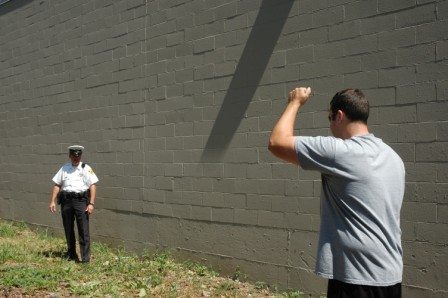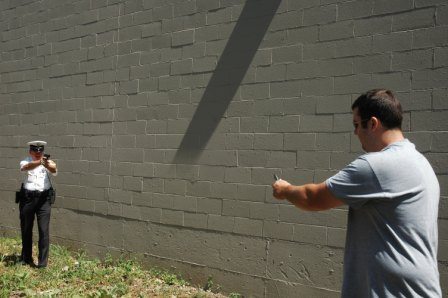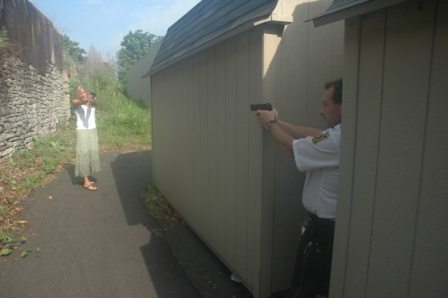Test Your Use of Force Knowledge
Police officers are forced to make many split second decisions during the course of their careers, and one of those decisions is when to use force. If they choose to use force they’re then faced with deciding which level of force should be employed. Should a Taser be used when a combative suspect is holding a knife? Should the officer go for her firearm if the suspect is swinging a baseball bat at her head? Is an officer ever justified to shoot an unarmed suspect? Are there situations when officers must retreat? All these decisions are made within one-half to three-quarters of a second. That’s about how long it takes the average human to react to a given situation.
Let’s first examine the scenario pictured above. Here, an officer stands facing a knife-wielding suspect who clearly presents a danger. The bad guy is holding an edged weapon (a knife) in the classic “ice pick” position. Years ago officers were taught that a suspect could be shot, and justifiably so, if he were wielding a knife in a threatening manner while positioned within a distance of twenty-one feet (the 21 foot rule) from the officer. The reasoning was that the suspect was without a doubt an immediate, deadly threat. Officers were taught that they’d not likely survive this scenario without using deadly force. In fact, it’s doubtful that an officer could draw his weapon and squeeze off a round, without aiming, if a suspect began his charge from a distance of twenty-one feet or less. Suppose the officer did properly assess the threat and did manage to draw his weapon and fire. How long would it take to think about and perform those two basic tasks?
The fastest officer tested was able to draw his weapon from a security holster in a little under 1.5 seconds. The slowest was a about 2.25 seconds. Sounds pretty fast, huh? Maybe not.
The average suspect can cover the distance (21 feet as seen above) from a standing still position to the officer in as little as 1.5 seconds, nearly a full second quicker than the slowest officer is able to defend himself.
Today officers must rethink the twenty-one foot rule a bit. Sure, the thug is potentially a deadly threat, but not an actual deadly threat until he makes some sort of hostile movement toward the officer. Of course the officer should have his firearm in a ready position as soon as he perceives the threat. And this is a situation where the officer should always choose his firearm over a non-lethal weapon, such as a Taser or pepperspray. Remember the the old saying, “Never bring a knife to a gunfight?” Now there’s a new addition to that rule. It’s, “Never bring a Taser to a knife fight.”
The key to knowing when it’s time to shoot is simple. If the officer feels that his life, or the life of an innocent person, is at risk, then the shoot is justified. However, the officer must be prepared to articulate his reasons for pulling the trigger. Was the suspect making stabbing motions while advancing? Was he charging the officer?
There are reasons that may not justify the shoot, such as the suspect being so intoxicated that he couldn’t possibly have followed through with the threat. In short, the threat must be real, or at least perceived as being real in the eyes of the officer.
And, the officer must be able to recognize when a threat is over. If the suspect drops his weapon the justification for deadly force ends immediately. The same is true when a suspect uses an automobile as a weapon. When a driver uses his car to charge an officer, the officer may shoot to stop the threat. However, when the car passes the officer the threat is over. The officer may not shoot at the fleeing car. Where would those rounds go? Besides, bullets won’t stop a moving car. Suppose the driver is shot? What happens to a driverless car that’s careening down a busy street at 40mph?
When a suspect points a firearm at an officer, deadly force is immediately justified.
In situations like the one pictured above, it’s not uncommon for officers to hesitate briefly before using force to stop the threat. Why? Interestingly, officers often perceive women and children as being less of a threat than a male suspect. That’s why FATS and other simulated firearms training uses both women and children in the shoot/don’t shoot scenarios. The woman in the picture above is very much a deadly threat; therefore, the officer is justified in using deadly force.
Let’s see how well you do with a short true or false quiz. The answers are posted at the end of the quiz.
True or False
1. There are constitutional limits on the types of weapons and tactics officers can use on the street.
2. An officer’s intent and state of mind at the time she used force can be an important factor in determining if that use of force was legal.
3. An officer must always retreat before using deadly force.
4. Officers MUST see a suspect’s weapon before using deadly force.
5. Officers must always use the least amount of force possible to gain control of a suspect.
6. Officers may shoot a fleeing felon.
7. Officers may not use force when conducting a pat down (Terry stop) search for weapons.
8. Information discovered after using force can be a factor in determining the legality of the force used.
9. Courts and juries are allowed to evaluate an officer’s use of force by considering what the officer could have done differently.
10. An officer’s prior use of force incidents can be considered in court when evaluating whether the use of force in a current situation was legally justified.
Quiz Source – Circuit Court Judge Emory Pitt, Jr. and Americans for Effective Law Enforcement
Answers 1F, 2F, 3F, 4F, 5F, 6T, 7F, 8F, 9F, 10F








I guess I’m the one who’s guilty of not reading YOUR entire statement. Sorry about that.
Lee,
I was commending you for being just in your statement by showing the counter argument.
No recording shows the ENTIRE event. There are going to be omissions; it is the nature of the beast.
In my area (St. Louis) most cruisers have cameras.
Tom, did you not read my entire statement? I included the counterargument in parenthesis. Yes, I basically agree with you. And yes, there are bad apples on both sides of the badge. But to use a recording (by either party) that doesn’t show an entire event, or just snippets that are skewed in favor of the photographer is wrong.
FYI – No, not all police cars have recording capability.
“…I can see how it would be frustrating as an officer to have one more thing to worry about during an event… ” -Theresa
There is nothing for the officer to worry about if he/she follows procedure. Perhaps I am mistaken, but don’t most cruisers have recording equipment? Are not all or nearly all traffic stops filmed by the officer? Is audio recorded also? Is the officer required to tell the ‘suspect’ that he/she is being recorded?
“One problem I see with the civilian recordings is that they only show one side of the incident (which can also be the argument against recordings made by police), only what the suspect wants to record.” -Lee Lofland
This is a just statement with appropriate counter argument. Is it not better to have both sides of the story? Especially in the rare instances when the officer in question is not on the straight and narrow? Sousveillance is the check and/or balance to the police’s use of surveillance.
I have yet to read/hear a valid argument against recording police officers on duty. I do not believe that there is a valid argument. Please prove me wrong.
Sorry it took me a while to check back, but thank you for your comments! There are interesting points both for and against taping of officers. I know from a civilian’s perspective, it feels reassuring to think that you might have a recorded account of events to use in court, or just to remember how a situation went. But I can see how it would be frustrating as an officer to have one more thing to worry about during an event… Looking forward to further discussion about this in the future!
Theresa – Actually, I’ve been loosely following this development. Mainly it’s the audio recordings that are causing people the problems. That’s illegal unless the recorded party has been advised of the recording. And that was the explanation given by the troopers who stopped Anthony Graber for driving his motorcycle in excess of 100mph. As far as the videotaping, there’s no expectation of privacy in public places. I think any officer who arrests someone for videotaping (without audio) will eventually lose the case.
One problem I see with the civilian recordings is that they only show one side of the incident (which can also be the argument against recordings made by police), only what the suspect wants to record. Such was the case in the Graber incident. His video showed him being stopped by an undercover officer in an unmarked car. What the helmet cam didn’t show was the marked unit that also participated in the traffic stop. So without seeing that side of the story all we have is a skewed view of the incident that leans heavily toward the defendant.
Then again, I wasn’t there so I really can’t make a totally knowledgeable comment about the incident.
Unrelated, but I read this interesting article today and would be interested in hearing your take on it from an officer’s perspective, http://gizmodo.com/5553765/are-cameras-the-new-guns thanks!
Elena – The rule of thumb is that once the threat decreases (a person running away from you can’t hurt you) then the level of force used must also decrease. However, if the fleeing felon is still shooting as he runs away, then officers may return fire and do what it takes to terminate the threat. Therefore, Joyce is correct, as usual.
Joyce, I did read about the Miranda ruling. In fact, I posted something about it on my Facebook page yesterday. This is basically what I wrote:
I really don’t see the problem. Basically, it’s always been this way. When officers read the Miranda warnings they ask the suspect if he understands each of the rights. Then the suspect signs the form and the questioning begins, unless the bad guy says I want an attorney, or I don’t want to talk. If they simply don’t say anything, well, you can’t make them answer your questions, but that wouldn’t stop me from asking them.
I’ve never finished reading the warnings, waited for the guy to sign the form, and then said, “Okay, so do you want a lawyer, or not?” Or, “Do you want to remain silent?” I did require each person to answer, verbally, that they understood each of the warnings, and I did so after I read each individual right. A nod of the head wasn’t enough.
You have the right to remain silent. “Do you understand that statement?”
Anything you say… “Do you understand that statement?”
I was watching Perry Mason and they cornered a murderer, who had them at gunpoint. Of course, this was Hollywood in the 1950’s, so Lt. Tragg stands in front of the loaded gun and begins his monologue of, “I know you wouldn’t shoot me. That’s not even your gun! You stole it from your ex-husband, and we know much more than that.”
And I’m freaking out because they’re convicting someone of murder and said murderer has their finger on the trigger.
Sigh! I should switch to NOVA.
I got them all right, too.
Elena, I was taught that the officer can shoot if the fleeing person is still a deadly threat to someone. Lee can correct me if I’m wrong.
Lee, did you hear about the recent Miranda ruling by the Supreme Court? What’s your take on it? I think it was a good decision.
Scary, I got them all correct. They trained me well. However, if you are so inclined I’d love more information on #6. I’ve never had a clear understanding. Seems to me you can’t just randomly shot someone because you know they are a felon. (defined as a “person convicted of a felony”.